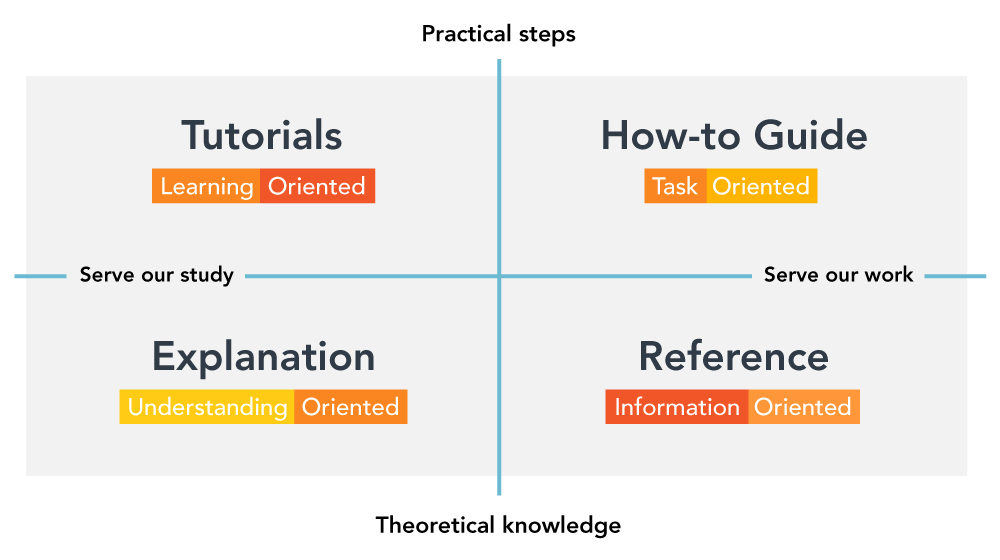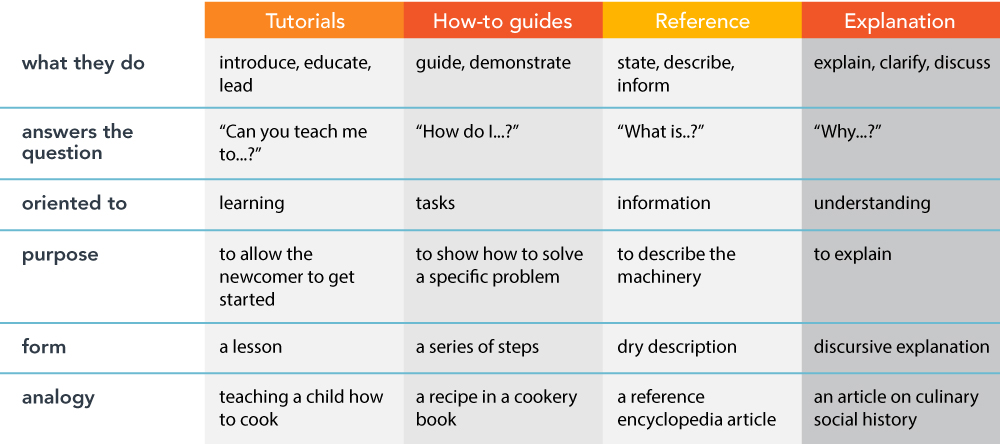Writing for
Good
Insights
In Brief
Have you ever wondered how to structure your technical documentation for maximum clarity and impact?
Diátaxis offers a systematic approach to technical communication, ensuring that your content is both informative and accessible. This article provides a basic introduction to Diátaxis, explaining its core principles and how they can be applied to your writing.

Guiding Beginners:
Learning Tutorials
- Tutorials are lessons that guide the reader through a series of steps to complete a project.
- A good tutorial should show learners that they can be successful with the product through meaningful and achievable actions.
- Tutorials are crucial for turning new learners into users of a product.
- To write a good tutorial, it’s essential to allow the user to learn by doing. The goal is to help the learner get started, not turn them into experts.
- The tutorial should be repeatable and work for users with different skill levels and resources. It should focus on concrete steps rather than abstract concepts.
- Explanation should be kept to a minimum, providing only what is necessary to complete the tutorial and avoiding unnecessary distractions.
- Options and alternatives should be omitted to maintain focus on the tutorial’s primary objective.
- The language in the tutorial should be clear, direct, and free of ambiguity.
Step-by-Step Solutions:
Crafting Effective How-To Guides
- How-to guides are step-by-step directions that help readers solve real-world problems, and they are (Goals and Task)-oriented.
- A good how-to guide should describe a sequence of actions in a logical order, starting from a known starting point and leading to a specific, helpful conclusion.
- A how-to guide’s primary focus is solving a problem or accomplishing a task. Extraneous explanations or concepts should be avoided; if necessary, they can be linked separately.
- Choosing clear and precise titles for how-to guides is crucial, as it helps users quickly understand what the guide covers.
The Ultimate Resource:
Designing Comprehensive References
- Reference guides are technical descriptions of machinery and how to operate it. They are information-oriented and serve as authoritative sources of truth and certainty for users.
- The primary purpose of a reference guide is to describe the product and its components, such as APIs, classes, functions, and how to use them effectively.
- Reference material should be concise, to the point, and devoid of ambiguity. Users consult it for accurate information rather than reading it like a narrative.
- Reference guides act as maps, providing essential information about the product’s internals without requiring users to explore the product themselves.
- The language of reference guides is factual, listing commands, options, warnings, and limitations to help users operate the machinery effectively.
Deep Dive:
Encourage Understanding with Detailed Explanations
- Explanation is focused on providing a deeper and broader understanding of a topic. It approaches subjects from various angles and perspectives.
- Unlike tutorials and how-to guides, the explanation does not concern specific user actions, and it differs from reference material, which offers detailed technical descriptions.
- Understanding is a fundamental aspect of any craft, and explanation plays a vital role in weaving together the practitioner’s knowledge and expertise.
- While explanation may not be as urgent as other forms of documentation, it is equally important. It helps practitioners grasp and retain knowledge, making it integral to mastering a craft.
Tutorials vs. How-to Guides
Tutorials
How-to guides
Purpose
Tutorials are focused on teaching beginners how to use a product or complete a project. They aim to build basic competence in using a product through hands-on learning
How-to guides are goal-oriented and provide step-by-step directions to help users solve real-world problems.
Content
Tutorials emphasize learning by doing, providing practical steps to achieve a specific outcome. They focus on “how to do it.”
How-to guides provide clear sequences of actions to solve a problem. They prioritize achieving a task efficiently.
Audience
Tutorials target new learners and aim to turn them into product users.
How-to guides target users looking to solve specific problems efficiently.
Language
Tutorials use clear, direct, and unambiguous language to guide users through concrete steps.
How-to guides use clear and precise titles to convey the guide’s content quickly
References vs. Explanations
References guides
Explanations
Purpose
Reference guides are technical descriptions of a product’s components and how to use them effectively. They serve as authoritative sources of information.
Explanations provide a deeper and broader understanding of a topic, approaching subjects from various angles
Content
Reference guides are concise and factual, listing commands, options, warnings, and limitations. They act as maps to the product’s internals.
Explanations focus on in-depth understanding and may explore topics from multiple perspectives.
Audience
Reference guides are consulted for accurate and specific information about a product’s components.
Explanations are for practitioners seeking a comprehensive understanding of a subject.
Language
Reference guides use factual language to provide clear technical information.
Explanations offer a broader view and may explore various aspects of a topic.

How to Get Started with Diátaxis
- Understand the Pragmatic Approach: Realize that Diátaxis is a tool to help you make your documentation better for users and more accessible to create and maintain. Approach it pragmatically, focusing on its practical application.
- Use Diátaxis as a Guide: View Diátaxis as a guide or map, not a strict plan. It’s designed to help you think about and understand your documentation, assess its problems, and identify areas for improvement.
- Don’t Worry About Structure Initially: Avoid spending too much energy trying to get the structure of your documentation perfect from the start. Instead, focus on improving the content based on Diátaxis principles.
- Just Do Something: Start by choosing any part of your documentation, even if it’s at random. Critically assess it based on user needs and Diátaxis standards. Decide on one immediate improvement and implement it.
- Cycle of Improvement: After making an improvement, return to the cycle’s beginning. Keep repeating the process, continuously identifying and addressing issues in your documentation.
- Allow Organic Development: Embrace the idea of well-formed organic growth for your documentation. Instead of rigidly planning and executing, let your documentation evolve and adapt naturally based on the improvements you make at the cellular level (small, individual changes).